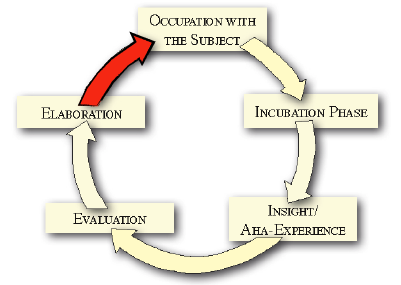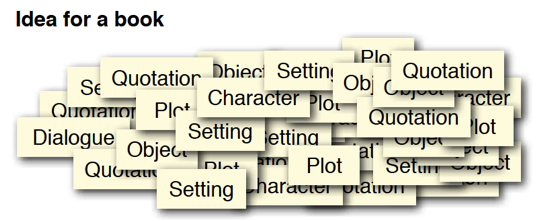Trust that little voice in your head that says “Wouldn’t it be interesting if …” And then do it.
“More Joy of Photography” by Duane Michals
When you are reading scientific literature, after a while you begin to develop an understanding of the issue. You begin to ask questions, e.g., why didn’t they measure this? Or, but wouldn’t intervention y be more effective? In short, once you occupy yourself with the topic ideas usually come. You need the knowledge first, but once you have it (at least partly), be ready to deal with the ideas.
One of the major points of Organizing Creativity is that you can make being creative more of a craft than an art. But for this to succeed, you must first occupy yourself with the topic and then capture and collect your ideas. If you look at the process model of creativity by Csikszentmihalyi, it’s cyclical (watch the red arrow).

It is also a simplified view, as the author mentioned, expect quick jumps between the different steps. However, it nicely illustrates that creativity is more than just one idea — and thus, more than you can always remember later.

An idea for a study is not just “I do x and measure y”. When you go into the details of how, when, and why, it becomes complicated quickly. So capture (= jot down your ideas) and collect them (= have a structure to deal with these ideas). The amount and quality of your ideas (over months!) will show you whether your system works. If not, modify it. You find a lot of ideas in the book.
A few quick tips when it comes to dealing with ideas:
- Ideas usually come during … “inopportune moments”, e.g., when walking, driving, showering, falling asleep, etc. Nevertheless, get them down immediately (use an audio recorder when driving and be careful!). You can facilitate this, e.g., by placing notepads and pens next to the shower, the bed, and keeping one with you all the time. Simply tear out the pages when you leave. I found that my smartphone allows me to capture ideas in bed without disturbing the person next to me. But there are other ways.
- Use a simple text file to quickly capture ideas on your computer. You can use Quicksilver on Mac, or simply put it into the Dock (Mac) or Task Bar (Windows) to have it available quickly. Text files open much faster than any Word file and are great to jot down ideas you have when you are focusing on something else.
- Use a “collection inbox” — which can be a text file on your computer where you type in all the ideas you jotted down somewhere else. The advantage is that you have them digitized and can include them in your backups. You can also move them quickly into your collection from that file.
- Use a collection — which can, for example, be a wiki, DEVONthink, a Word file, whatever. If you work on a project a separate file for that project might be useful. E.g., if you are doing a study, use the structure you would use in a paper to place the ideas in the right place. The difference between a file drawer full of jotted down notes you never use and a growing and improving collection of ideas for a project is structure. Use a collection that is useful for you, which helps you to remember, generate, find, expand and restructure your ideas. You find a couple of possible solutions in “Organizing Creativity”.
- For any kind of study, document what you do and why you did do it. Some studies take years and in the end you might not remember why you made certain choices (happened to me and people I know).
- Write down ideas you cannot realize, but put them on a “someday” or “future research” list. In engineering there is “feature creep”, in science there is “variable creep”. You will have ideas for a lot of things to manipulate and measure, but you have to cut it down to the currently most relevant variables. Otherwise, you cannot conduct or analyze the study. A series of smaller, focused studies is preferable to one large, unwieldy study — until you really, really know how experiments usually turn out in that area. So focus, cut down the topic and write down your ideas for future studies.
- If you want to develop complex creative projects (e.g., a study), develop ideas on a whiteboard (or use MagicCharts). This way you can develop ideas over longer time frames (a week to a month), walk up in front of it and augment it. It’s also very good for short discussions with colleagues, because everything is externalized on that wall. Photograph it occasionally in case something happens to it. (Don’t use this in labs where ideas are stolen. Use a PowerPoint/Keynote file, select a very large slide size and develop your ideas there. Not as nice but more protected.)
Like written, you find a lot of other ways to deal with ideas in “Organizing Creativity” — it’s one of the main reasons I wrote this book in the first place.